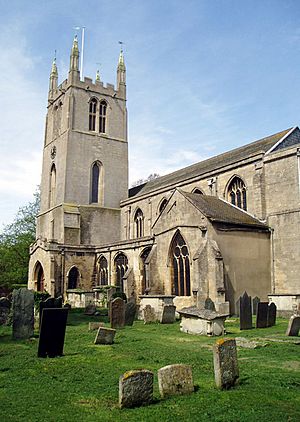Bourne Abbey facts for kids
Quick facts for kids Bourne Abbey |
|
|---|---|
| Parish Church of St. Peter and St. Paul | |
 |
|
| Location | Church Walk Bourne, Lincolnshire PE10 9UQ |
| Country | United Kingdom |
| Denomination | Church of England |
| Previous denomination | Roman Catholic |
| History | |
| Status | Parish church |
| Founded | 1138 |
| Founder(s) | Baldwin FitzGilbert |
| Architecture | |
| Functional status | Active |
| Specifications | |
| Number of towers | 1 |
| Administration | |
| Diocese | Lincoln |
Bourne Abbey and the Parish Church of St. Peter and St. Paul is a very old and important church in Bourne, Lincolnshire, England. It is a special building, known as a Grade I church. It has been used for worship since it was founded in 1138. Even after big changes in the 1500s, called the Dissolution, the church continued to serve the local community. This is because the main part of the church, called the nave, was always used by the people of the parish.
Contents
Monastic History of Bourne Abbey
Records show there was a church in Bourne as early as 1066. Some even think there might have been an Anglo-Saxon abbey before that. However, the abbey we know today was officially started in 1138. It was founded by a powerful man named Baldwin fitz Gilbert de Clare. He was part of a Norman family that came to England after the Norman Conquest.
Baldwin founded the abbey for up to 14 canons. These were like priests who lived together under special rules, following the Rule of St. Augustine. This was a time when many abbeys and castles were being built across England.
The abbey's founding was part of a bigger plan to change the town. The current town centre was built as a new town next to Baldwin's new castle. The main road at that time ran right between the castle and the abbey. This might be why Baldwin chose the Arrouaisian order for the abbey. This group was known for helping travelers.
Later, in the late 1200s, the area around Bourne Castle was changed again. The main road was moved away from the abbey and onto what used to be part of the castle grounds. The abbey was closed down in 1536. This happened during the first part of King Henry VIII's Dissolution of the Monasteries. This was when many monasteries in England were shut down by the King.
Abbots of Bourne Abbey
Over the centuries, many abbots led Bourne Abbey. The first known abbot was Gervaise of Arrouaise, who started in 1138. The last abbot was John Small, who was in charge in 1534, just before the abbey closed in 1536.
Literary Connections
Bourne Abbey has some interesting links to old English literature.
The Ormulum
The Ormulum is a very important old book. It's a special kind of Bible commentary that helps us understand how the English language changed. It was likely written in Bourne Abbey around 1175 by a person named Orm the Preacher. This book helps bridge the gap between Old English and Middle English.
Robert Mannyng
Robert Mannyng, also known as Robert de Brunne, was a famous writer from the early 1300s. He helped bring English writing back into fashion after Latin and Anglo-Norman languages were more popular. People often say he was a monk at Bourne Abbey. However, he was actually a Gilbertine monk, and Bourne Abbey followed a different order. His name, "de Brunne," probably means he came from the town of Bourne. Since the abbey's nave was also the parish church, young Robert would have known it well before he left for Sempringham in 1288.
Notable Burials
Some important people were buried at Bourne Abbey:
- Thomas Holland, 2nd Earl of Kent (who lived from about 1350 to 1397)
- Edmund Holland, 4th Earl of Kent


